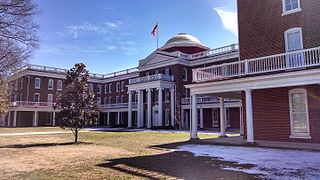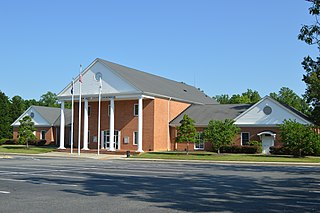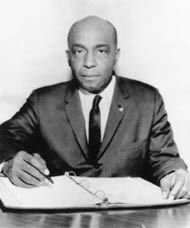Brown v. Board of Education of Topeka, 347 U.S. 483 (1954), was a landmark decision of the U.S. Supreme Court that ruled that U.S. state laws establishing racial segregation in public schools are unconstitutional, even if the segregated schools are otherwise equal in quality. The decision partially overruled the Court's 1896 decision Plessy v. Ferguson, which had held that racial segregation laws did not violate the U.S. Constitution as long as the facilities for each race were equal in quality, a doctrine that had come to be known as "separate but equal". The Court's unanimous decision in Brown, and its related cases, paved the way for integration and was a major victory of the civil rights movement, and a model for many future impact litigation cases.

Prince Edward County is located in the Commonwealth of Virginia. As of the 2020 census, the population was 21,849. Its county seat is Farmville.

New Kent County is a county in the south eastern part the Commonwealth of Virginia. As of the 2020 United States Census, its population was 22,945. Its county seat is New Kent.
Swann v. Charlotte-Mecklenburg Board of Education, 402 U.S. 1 (1971), was a landmark United States Supreme Court case dealing with the busing of students to promote integration in public schools. The Court held that busing was an appropriate remedy for the problem of racial imbalance in schools, even when the imbalance resulted from the selection of students based on geographic proximity to the school rather than from deliberate assignment based on race. This was done to ensure the schools would be "properly" integrated and that all students would receive equal educational opportunities regardless of their race.

Desegregation busing was an attempt to diversify the racial make-up of schools in the United States by sending students to school districts other than their own. While the 1954 U.S. Supreme Court landmark decision in Brown v. Board of Education declared racial segregation in public schools unconstitutional, many American schools continued to remain largely racially homogeneous. In an effort to address the ongoing de facto segregation in schools, the 1971 Supreme Court decision, Swann v. Charlotte-Mecklenburg Board of Education, ruled that the federal courts could use busing as a further integration tool to achieve racial balance.
Massive resistance was a strategy declared by U.S. senator Harry F. Byrd Sr. of Virginia and his son Harry Jr.'s brother-in-law, James M. Thomson, who represented Alexandria in the Virginia General Assembly, to get the state's white politicians to pass laws and policies to prevent public school desegregation, particularly after Brown v. Board of Education.

Segregation academies are private schools in the Southern United States that were founded in the mid-20th century by white parents to avoid having their children attend desegregated public schools. They were founded between 1954, when the U.S. Supreme Court ruled that segregated public schools were unconstitutional, and 1976, when the court ruled similarly about private schools.
Arlington Public Schools is a public school division in Arlington County, Virginia. In 2019, student enrollment was 28,020 students, with students coming from more than 146 countries. In 2015, there were 2,166 teachers. There are 24 elementary schools, 6 middle schools, 4 high schools, 1 secondary institution and 4 other educational programs within the school district.

Coral Gables Preparatory Academy, formerly Coral Gables Elementary School, is a public K-8 school in Coral Gables, Florida. A part of the Miami-Dade County Public Schools, it has its elementary school classes in the Lower Academy, in the former Coral Gables Elementary building, while the middle school classes are in the Upper Academy at the Merrick Educational Center. The school was given its current name in 2010.

New Kent is a census-designated place (CDP) in and the county seat of New Kent County, Virginia, United States. The population as of the 2020 Census was 739.

The Robert Russa Moton Museum is a historic site and museum in Farmville, Prince Edward County, Virginia. It is located in the former Robert Russa Moton High School, considered "the student birthplace of America's Civil Rights Movement" for its initial student strike and ultimate role in the 1954 Brown v. Board of Education case desegregating public schools. It was designated a National Historic Landmark in 1998, and is now a museum dedicated to that history. In 2022 it was designated an affiliated area of Brown v. Board of Education National Historical Park. The museum were named for African-American educator Robert Russa Moton.

Sylvia Mendez is an American civil rights activist and retired nurse. At age eight, she played an instrumental role in the Mendez v. Westminster case, the landmark desegregation case of 1946. The case successfully ended de jure segregation in California and paved the way for integration and the American civil rights movement.
Green v. County School Board of New Kent County, 391 U.S. 430 (1968), was an important United States Supreme Court case involving school desegregation. Specifically, the Court dealt with the freedom of choice plans created to avoid compliance with the Supreme Court's mandate in Brown II in 1955. The Court held unanimously that New Kent County's freedom of choice plan did not adequately comply with the school board's responsibility to determine a system of admission to public schools on a non-racial basis. The Supreme Court mandated that the school board must formulate new plans and steps towards realistically converting to a desegregated system. Green v. County School Board of New Kent County was a follow-up of Brown v. Board of Education.

New Kent High School is a historic school in New Kent, Virginia. The school, along with the nearby George W. Watkins Elementary School, is associated with the landmark Supreme Court case Green v. County School Board of New Kent County (1968), in which the court defined what the standards of Brown v. Board of Education were in the desegregation cases. This decision ended the era of Massive Resistance and ushered in the era of integration.
Alexander v. Holmes County Board of Education, 396 U.S. 19 (1969), was a United States Supreme Court case in which the Court ordered immediate desegregation of public schools in the American South. It followed 15 years of delays to integrate by most Southern school boards after the Court's ruling in Brown v. Board of Education (1954) that segregated public schools were unconstitutional.
Daniel Holcombe Thomas was a United States district judge who served nearly five decades on the United States District Court for the Southern District of Alabama.

Samuel Wilbert Tucker was an American lawyer and a cooperating attorney with the National Association for the Advancement of Colored People (NAACP). His civil rights career began as he organized a 1939 sit-in at the then-segregated Alexandria, Virginia public library. A partner in the Richmond, Virginia, firm of Hill, Tucker and Marsh, Tucker argued and won several civil rights cases before the Supreme Court of the United States, including Green v. County School Board of New Kent County which, according to The Encyclopedia of Civil Rights In America, "did more to advance school integration than any other Supreme Court decision since Brown."

School segregation in the United States was the segregation of students in educational facilities based on their race and ethnicity. While not prohibited from having or attending schools, various minorities were barred from most schools that admitted white students. Segregation was enforced legally in the U.S. states, primarily in the Southern United States, although segregation could occur in informal settings or through social expectations and norms. Segregation laws were met with resistance by Civil Rights activists and began to be challenged in 1954 by cases brought before the U.S. Supreme Court. Segregation continued longstanding exclusionary policies in much of the Southern United States after the Civil War. Jim Crow laws codified segregation. These laws were influenced by the history of slavery and discrimination in the US. Secondary schools for African Americans in the South were called training schools instead of high schools in order to appease racist whites and focused on vocational education. School integration in the United States took place at different times in different areas and often met resistance. After the ruling of Brown v. Board of Education, which banned segregated school laws, school segregation took de facto form. School segregation declined rapidly during the late 1960s and early 1970s as the government became strict on schools' plans to combat segregation more effectively as a result of Green v. County School Board of New Kent County. Voluntary segregation by income appears to have increased since 1990. Racial segregation has either increased or stayed constant since 1990, depending on which definition of segregation is used. In general, definitions based on the amount of interaction between black and white students show increased racial segregation, while definitions based on the proportion of black and white students in different schools show racial segregation remaining approximately constant.

In the United States, school integration is the process of ending race-based segregation within American public and private schools. Racial segregation in schools existed throughout most of American history and remains an issue in contemporary education. During the Civil Rights Movement school integration became a priority, but since then de facto segregation has again become prevalent.
This is a timeline of the civil rights movement in the United States, a nonviolent mid-20th century freedom movement to gain legal equality and the enforcement of constitutional rights for people of color. The goals of the movement included securing equal protection under the law, ending legally institutionalized racial discrimination, and gaining equal access to public facilities, education reform, fair housing, and the ability to vote.















